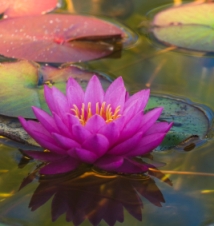Last Tuesday around noon, I returned home from a short errand on my bike very hot (it was 115 or so degrees that day) and irritated. I had to ride my bike because of a family transportation snafu. I’d left my car at my boyfriend Peter’s flower shop, and the next morning, he went out of town on business.
As I wheeled my bike around the side of our house toward the back yard, I passed our small fish pond. It’s surrounded by the wild-looking desert plants and bushes that Peter, a horticulturist, has planted there in his effort to nest us in foliage while conserving water. Amid the brittle yellows and papery silvers of their leaves, in the center of the water, floated a lipstick pink water lily in full bloom. Its flat leaves bobbed around the flower like adoring fans.
 I stopped for a moment to consider this little miracle in the full midday sun. My irritation dissolved as sweat dripped down my sides and temples. Peter had put the plant in the pond for me, knowing the importance of the lotus (another name for the water lily) in the Hindu mythology that I love. I was overcome by his thoughtfulness and the flower’s opportune fruition.
I stopped for a moment to consider this little miracle in the full midday sun. My irritation dissolved as sweat dripped down my sides and temples. Peter had put the plant in the pond for me, knowing the importance of the lotus (another name for the water lily) in the Hindu mythology that I love. I was overcome by his thoughtfulness and the flower’s opportune fruition.
The image of the lily and its effect on my state stayed with me all day, and as I prepared to teach my two yoga classes that evening.
The symbol of the lotus appears frequently in yoga texts. For instance, lotuses of varying colors and number of petals are used to represent each of the chakras in the subtle body system popularized by kundalini yoga. The crown of the head (Sahasrara chakra) is depicted as the thousand-petaled lotus, the seat of Shiva-Shakti.
The lotus blossom’s rise from the muck where it’s grounded is rife with figurative potential. It’s easy to see in it the human spirit’s ability to triumph over lowly circumstances and produce beauty. This was the aspect of the flower in my pond that resonated with me that day.
Because of his commitment to natural gardening practices, Peter uses no chemicals to maintain the pH of our pond. While our fish appear to adore the gnat-covered water, to me it resembles moss broth. I can only imagine what the bottom, where the lily is rooted, must be like. At the opposite end, its fragile bloom defied the blistering Mojave sun.
I’ve written before in this blog about how tough times are for Las Vegans. In May, our city’s unemployment rate surpassed 14%, and in this morning’s Las Vegas Sun, publisher Brian Greenspun opined about how many bad lists the city is No. 1 on. I doubt any resident of this city has remained completely untouched by the economic crisis that is crushing us all, collectively.
I’m aware of this every time I walk into the yoga studio to teach a class. Even in that environment, whose price of admission attests to the relative affluence of its members, I know there are people who are suffering from the loss of jobs and homes. Some have shared with me their struggles; I can see them trying to make sense of it all through their yoga practice.
Tuesday evening, as the students quieted down and settled into Balasana (child’s pose), I told them the story of the lily blooming in my pond, how its delightful contextual incongruity had melted my frustration. They moved through the practice of pranayama and asana, and I encouraged them to use the form of their breath and bodies to reflect on the unfolding of their consciousness. We finished the class seated in Padmasana (lotus pose), meditating on allowing our hearts to open, like the petals of a flower, to our inner divinity.
A sense of solace lingered in the air as the class ended and the students rolled up their mats. Some thanked me on their way out, seeming to have left a weight behind. Together, I think we learned that each one of us can plant a lotus in her own soul. When cultivated with love and nourished properly, that lotus will bloom in the most surprising circumstances – like the desert in July, during a recession.

